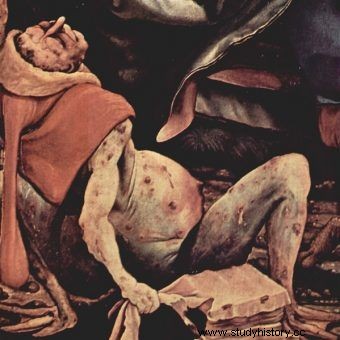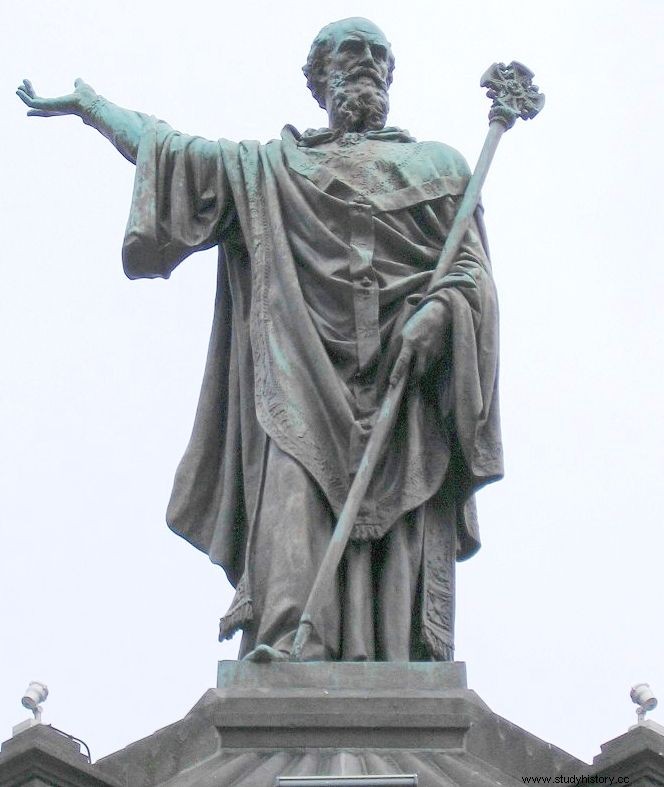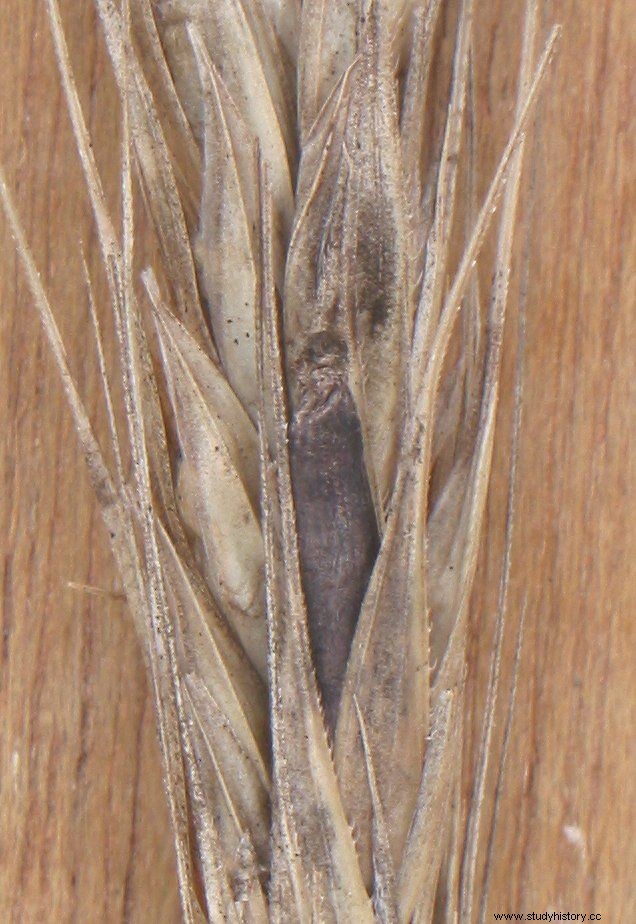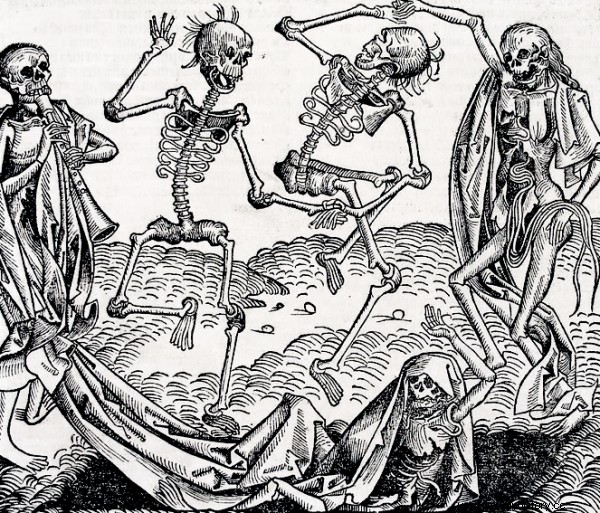Our ancestors called it "St. Anthony's fires". Tens of thousands of people died of it in unimaginable torments. It took centuries to find the causes of this disease - even though the enemy was at hand every day.
The first mentions of an atypical disease come from France. In 590, behaviors attributed to satanic possession were described. The epidemics of this "possession" repeated every few or several years, usually after an unfruitful harvest. The next cases described in the chronicles took place in 857 in Xanthan on the lower Rhine. Paris was affected in 945 and Aquitaine and Limousin in 994. The last of these mysterious plague attacks turned out to be the most tragic. As a result, died over 40,000 people .

Painting by Matthias Grünewald. This is what the sufferers of St. Anthony's Fire looked like.
Although the causes of the disease were not known, attempts were made to combat it. Two years after the epidemic in Aquitaine, the bishop of Metz founded a hospital for those suffering from what was then called "plague" or "holy fire." Another, founded on the order of Pope Urban II, was established in 1093 in Vienne in Delfinata. All of this to no avail. In each year following a poor grain harvest, more sufferers appeared.

The pontificate of Urban II coincided with turbulent times in the history of the Church. However, the Pope did not forget about the faithful. That is why in 1093 he commissioned a hospital in Delfinata.
Limbs falling off
All descriptions of the deadly disease look similar. However, it took until the 18th century for a full description of its symptoms and treatment methods. Such a description appeared in the Saillant Memorial in 1777:
Violent convulsions are feature essential this disease. Ma she mileage not regular and returns periodically is less dangerous but promises to be more terrifying (than dry gangrene). The sick person feels the fire that is devouring him, then the cold, as if water were being applied to him.
These symptoms are accompanied by loss of appetite, nausea, vomiting, and shortly thereafter unprecedented pains, the patient suffers without a tear, howls in pain, limbs are subject to very violent contractions and sometimes they are straightened and stiff without being bent. The pain subsides when you manage to straighten the affected limbs or bend the stiff ones, but the pain returns with a new attack. (…)
There are usually other conditions within a few weeks, such as dizziness, tinnitus, deafness, and loss or impairment of vision. (...) If during an attack of illness there is confusion of the senses, this affliction remains for the rest of life.
The eighteenth-century researchers emphasized that the patients most often suffered from sensory disturbances, abdominal pain and convulsions. They were accompanied by hallucinations which made them considered possessed. The "fires of St. Anthony" particularly often attacked the limbs. They led to gangrene and necrosis. Many chronicles contain drastic descriptions of falling, blackened arms and legs, as well as noses, breasts and penises . To this day, they make an impression that is hard to shake off. No wonder that mysterious epidemics also inspire writers today, as exemplified by Jeanne Bourin's novel "The Big Fire" devoted to the "plague".
The disease of the poor
For a very long time, it was impossible to discover the causes of the unusual disease. The breakthrough came when three scholars, two French and a Swede, independently concluded that ergot might be to blame. It is a dilated kernel of rye, which is stimulated to grow by the fungus - red bunny.
Ergot was once of special importance to peasants. As Ryszard Rzad from the Castle Museum in Malbork writes:
In the old days, the appearance of ergot in the grain was supposed to be a good harvest. In some regions, the tradition of finding the so-called mother of grain or rye mother, i.e. a double-ended or an exceptional-sized ear, was associated with the search for ears infected with roundworm. The unique specimens of grain ears, together with the ears with spores, were braided into a bouquet, which was placed on the ceiling of the hut to sow these seeds first during the sowing season.

The cause of St. Anthony's fires, hallucinating and causing death, is poisoning by ergot, a fungus that affects around 400 plant species.
In the sources from the 17th and 18th centuries, it can be read that the poor did not separate ergot from healthy ears. This made it possible to produce more bread and, it was believed, to win favor with the spirits. This practice was noticed by a French, Father Teissier. He conducted research in the Sologne area, where attempts were made to describe the disease in the 1770s.
At about the same time, Thuillier, Prince Sully's personal physician, announced in the Journal des sçavans, the first European scientific journal, that ergot could be the cause of the disease. Following this trail, Teissier isolated the suspicious grains, pulverized them and gave them to pigs and ducks. He observed similar symptoms in animals as in humans:cramps, diarrhea, necrosis of the limbs and symptoms of psychosis. In 1778 he presented the results of his research at the Academy of Medicine in Paris. It was a turning point.
After the sources of the "plague" had been identified, epidemics became less frequent. The last numerous cases of the disease were recorded in Germany and Hungary at the end of the 18th century. In the nineteenth century, only in Russia was "holy fire" used on a massive scale. The last group poisoning with a hallucinogenic fungus was noticed in eastern Małopolska in 1895.

Due to epidemics decimating people, the theme of "dance of death" was extremely popular in medieval art.
Interestingly, in the meantime ergot also appeared in medicine as ... a medicine. Aleksander Drygas, habilitated doctor of pharmaceutical sciences writes:
Ergot - after all - poison, entered medical treatment as early as the 16th century. In 1588, Wendelin Thallius used ergot as a blood-stopping agent. Similarly, J. Camerarius used ergot for bleeding during labor (...). Paracelsus was right when he said that “everything is poison and nothing is poison. Here the size of the dose is decisive ".
